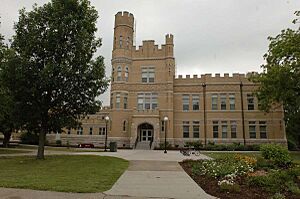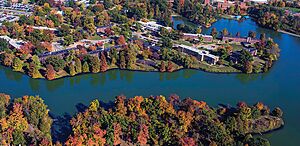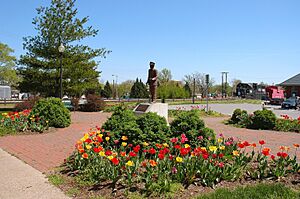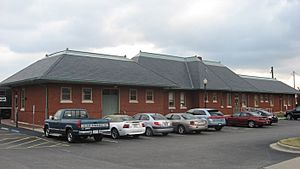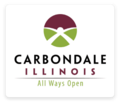Carbondale, Illinois facts for kids
Quick facts for kids
Carbondale, Illinois
|
|||||
|---|---|---|---|---|---|
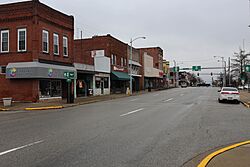
South Illinois Avenue
|
|||||
|
|||||
| Nickname(s):
Eclipse Crossroads of America
|
|||||
| Motto(s):
All Ways Open
|
|||||
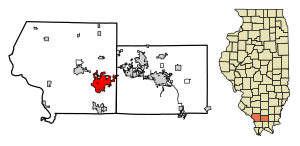
Location of Carbondale in Jackson County, Illinois
|
|||||
| Country | United States | ||||
| State | Illinois | ||||
| County | Jackson, Williamson | ||||
| Townships | Carbondale, Murphysboro, Makanda | ||||
| Precincts | Carterville | ||||
| Founded | 1852 | ||||
| Incorporated Town | 1856 | ||||
| Government | |||||
| • Type | Council–manager | ||||
| Area | |||||
| • Total | 17.86 sq mi (46.25 km2) | ||||
| • Land | 17.42 sq mi (45.13 km2) | ||||
| • Water | 0.43 sq mi (1.13 km2) | ||||
| Elevation | 449 ft (137 m) | ||||
| Population
(2020)
|
|||||
| • Total | 25,083 | ||||
| • Density | 1,254.49/sq mi (484.36/km2) | ||||
| Time zone | UTC−6 (CST) | ||||
| • Summer (DST) | UTC−5 (CDT) | ||||
| ZIP Codes |
62901, 62902, 62903
|
||||
| Area code(s) | 618 | ||||
| FIPS code | 17-11163 | ||||
| GNIS feature ID | 2393739 | ||||
| Public Transit | Jackson County Mass Transit District South Central Transit |
||||
Carbondale is a city in Jackson County, Illinois, United States. It's located in a part of Southern Illinois often called "Little Egypt." In 2020, about 25,083 people lived there. This makes it the biggest city in Southern Illinois, except for the area near St. Louis.
Carbondale was started in 1853. It grew because it was a key spot for railroads. Today, major roads like Illinois Route 13 and U.S. Route 51 meet in the city. Carbondale is about 96 miles southeast of St. Louis. It sits on the edge of the Shawnee National Forest. It's also home to the main campus of Southern Illinois University.
Contents
- Carbondale's Story: A Look at Its History
- Where is Carbondale? Its Geography
- Who Lives in Carbondale? Demographics
- Carbondale's Creative Side: Arts and Culture
- Shopping and Eating: Retail in Carbondale
- Get Active! Parks and Recreation
- Getting Around: Transportation
- Notable people
- Sister cities
- Images for kids
- See also
Carbondale's Story: A Look at Its History
In August 1853, three men named Daniel Harmon Brush, John Asgill Conner, and Dr. William Richart bought a large piece of land. It was located between two planned railroad stops and two county towns. Brush decided to name the new settlement Carbondale. He chose this name because there was a lot of coal in the area. The very first train came through Carbondale on July 4, 1854. It was traveling north from Cairo, Illinois.
By the time of the American Civil War, Carbondale had become an important center. It was a hub for transportation and business. Farms surrounded the city, helping it grow. This part of Illinois was called "Little Egypt." This nickname came from where the Ohio and Mississippi rivers meet, near the town of Cairo.
Carbondale has had a college since 1856. It started as Carbondale College, founded by Presbyterians. Later, it became an elementary school. Carbondale also won the chance to host a new state teacher training school. This school, called Southern Illinois Normal University, opened in 1874. This brought new jobs and people to the town. It also helped public schools. In 1947, the school's name changed to Southern Illinois University. It is now the main campus of the Southern Illinois University system. This university is known for its research. In 2014, it had nearly 18,000 students. It offers many different subjects for students to study.
On April 29, 1866, Carbondale held one of the first Memorial Day events after the Civil War. It took place at Woodlawn Cemetery. General John A. Logan, who lived in the area, gave the main speech.
In the early 1900s, Carbondale was known as the "Athens of Egypt." This was because the college and university were growing. The region was already called "Little Egypt." People started using the phrase "Athens of Egypt" around 1903. By 1922, a local newspaper, the Carbondale Free Press, even used it on its front page.
Where is Carbondale? Its Geography
Carbondale is located at about 37.726 degrees North and 89.220 degrees West. It is in the area where water flows into the Big Muddy River. The city is about 415 feet (126 meters) above sea level. Carbondale is special because it will be in the path of two total solar eclipses. The first was on August 21, 2017. The longest time of darkness, 2 minutes and 41.6 seconds, was just south of the city. The second eclipse will be on April 8, 2024.
In 2010, Carbondale covered about 17.5 square miles (45.4 square kilometers). Most of this area, about 17.09 square miles (44.26 square kilometers), is land. The rest, about 0.429 square miles (1.11 square kilometers), is water.
Carbondale's Weather: Climate Overview
Carbondale has a humid subtropical climate. This means it has four clear seasons. The average daily temperature in January is about 32.4°F (0.2°C). In July, it's about 78.1°F (25.6°C). On average, the temperature reaches 90°F (32°C) or higher about 40 days a year. It stays below freezing about 16 days a year. Very cold temperatures, below 0°F (-18°C), happen about 2 to 3 nights a year.
The city gets about 47.2 inches (120 cm) of rain each year. It also gets about 11 inches (28 cm) of snow. The coldest temperature ever recorded was -25°F (-32°C) on January 11, 1977. The hottest was 113°F (45°C) on August 9, 1930.
Carbondale has thunderstorms about 50 days a year. In the spring, these storms can be very strong. They can bring high winds, damaging hail, and even tornadoes.
| Climate data for Carbondale, Illinois (1981–2010 normals) | |||||||||||||
|---|---|---|---|---|---|---|---|---|---|---|---|---|---|
| Month | Jan | Feb | Mar | Apr | May | Jun | Jul | Aug | Sep | Oct | Nov | Dec | Year |
| Record high °F (°C) | 76 (24) |
79 (26) |
93 (34) |
92 (33) |
101 (38) |
108 (42) |
112 (44) |
113 (45) |
108 (42) |
96 (36) |
88 (31) |
77 (25) |
113 (45) |
| Mean daily maximum °F (°C) | 41.8 (5.4) |
46.9 (8.3) |
57.1 (13.9) |
68.3 (20.2) |
77.0 (25.0) |
85.6 (29.8) |
89.0 (31.7) |
88.7 (31.5) |
81.6 (27.6) |
70.3 (21.3) |
57.7 (14.3) |
45.0 (7.2) |
67.5 (19.7) |
| Mean daily minimum °F (°C) | 23.0 (−5.0) |
26.2 (−3.2) |
34.6 (1.4) |
44.3 (6.8) |
54.6 (12.6) |
63.6 (17.6) |
67.3 (19.6) |
64.3 (17.9) |
55.3 (12.9) |
43.7 (6.5) |
35.6 (2.0) |
25.9 (−3.4) |
44.9 (7.2) |
| Record low °F (°C) | −25 (−32) |
−22 (−30) |
−11 (−24) |
20 (−7) |
29 (−2) |
39 (4) |
42 (6) |
41 (5) |
30 (−1) |
16 (−9) |
−1 (−18) |
−14 (−26) |
−25 (−32) |
| Average precipitation inches (mm) | 3.06 (78) |
3.08 (78) |
4.15 (105) |
4.45 (113) |
5.37 (136) |
4.51 (115) |
3.66 (93) |
3.26 (83) |
3.14 (80) |
3.81 (97) |
4.63 (118) |
4.05 (103) |
47.17 (1,199) |
| Average snowfall inches (cm) | 3.0 (7.6) |
4.1 (10) |
1.2 (3.0) |
0 (0) |
0 (0) |
0 (0) |
0 (0) |
0 (0) |
0 (0) |
0 (0) |
trace | 2.6 (6.6) |
11.0 (28) |
| Average precipitation days (≥ 0.01 in) | 9.5 | 8.6 | 11.5 | 11.4 | 12.5 | 9.4 | 8.6 | 7.9 | 7.7 | 8.3 | 10.2 | 10.8 | 116.4 |
| Average snowy days (≥ 0.1 in) | 1.7 | 1.7 | 0.4 | 0 | 0 | 0 | 0 | 0 | 0 | 0 | 0 | 1.6 | 5.4 |
| Source: NOAA (extremes 1898–present) | |||||||||||||
Who Lives in Carbondale? Demographics
| Historical population | |||
|---|---|---|---|
| Census | Pop. | %± | |
| 1880 | 2,213 | — | |
| 1890 | 2,832 | 28.0% | |
| 1900 | 3,318 | 17.2% | |
| 1910 | 5,411 | 63.1% | |
| 1920 | 6,207 | 14.7% | |
| 1930 | 7,528 | 21.3% | |
| 1940 | 8,550 | 13.6% | |
| 1950 | 10,921 | 27.7% | |
| 1960 | 14,670 | 34.3% | |
| 1970 | 22,816 | 55.5% | |
| 1980 | 26,414 | 15.8% | |
| 1990 | 27,033 | 2.3% | |
| 2000 | 25,597 | −5.3% | |
| 2010 | 25,902 | 1.2% | |
| 2020 | 25,083 | −3.2% | |
| U.S. Decennial Census | |||
In 2020, Carbondale had 21,857 people living there. There were 11,103 households and 3,757 families. The city had about 1,226 people per square mile (473 per square kilometer).
The people living in Carbondale were from many different backgrounds:
- 54.33% were White.
- 25.74% were African American.
- 0.53% were Native American.
- 7.86% were Asian.
- 0.07% were Pacific Islander.
- 3.88% were from other races.
- 7.58% were from two or more races.
- About 7.48% of the population was Hispanic or Latino (who can be of any race).
About 15.4% of households had children under 18. About 18.83% were married couples. Many households, 66.16%, were not families. About 49.42% of all households were people living alone. About 8.30% of these were people aged 65 or older living alone.
The average age of people in Carbondale was 25.0 years. About 11.9% of the population was under 18. About 38.3% were between 18 and 24 (many of these are likely university students).
Carbondale's Creative Side: Arts and Culture
Carbondale is home to Southern Illinois University (SIU). The university often hosts concerts, plays, and art shows. But the city also has many other cool cultural places.
SIU has its own teaching museum, the University Museum. It has over 60,000 items in its collection. It also brings in art shows from famous artists. Besides the University Museum, there's the African American Museum and The Science Center. If you like theater, you can see plays by both professional actors and students. These shows happen at the university's McLeod and Kleinau Theaters.
SIUC also has the biggest auditorium in Southern Illinois, called Shryock Auditorium. Many famous performers have played there, like B.B. King, the Supremes, Ray Charles, and Judy Collins. Orchestras and other music groups also perform there. Carbondale is also home to Lost Cross. This is one of the longest-running DIY punk music venues in the country. It hosts both local and national bands.
You can also watch plays by the Jackson County Stage Company (Stage Company). In 2007, this group teamed up with Carbondale Community Arts (CCA). They bought and fixed up the Varsity Theater, which had been empty since 2003. Now it's the Varsity Center for the Arts (VCA). The Stage Company performs there, and the VCA also supports other arts and performances through the CCA.
Many groups encourage people to get involved in the community. These include Carbondale Conversations for Community Action. There are also several clubs like the Fraternal Order of Eagles, Elks, Rotary International, and the A.F.A.M (Freemasonry).
The Women's Center has been helping people since 1972. It was one of the first places in the United States to help people dealing with domestic violence.
Carbondale has many places for different beliefs. There are churches for various Christian groups, a Unitarian Universalist fellowship, two mosques, a Jewish group, and two Buddhist groups. The first Hindu temple in Southern Illinois opened in Carbondale in June 2013. The Gaia House Interfaith Center is a place where people from different cultures can meet. It also helps the community learn about being more eco-friendly.
Some notable poets live in or near Carbondale. These include Rodney Jones, Judy Jordan, Allison Joseph, and the Transpoetic Playground group. Carbondale also has a growing stand-up comedy scene. Famous comedian Hannibal Buress started his comedy career in the city.
Fun Times: Events in Carbondale
Carbondale is known for its yearly festivals:
- The Lights Fantastic parade in December.
- The Big Muddy Film Festival in February or March.
- The Southern Illinois Irish Festival in April.
- The Indian celebration of Diwali in October or November.
- The Great Cardboard Boat Regatta in April.
- The Sunset Concerts, a free outdoor concert series in the summer. These happen on the SIU campus and in city parks.
- Brown Bag Concerts, a free outdoor concert series in the spring and fall. These take place in the Town Square Pavilion.
Shopping and Eating: Retail in Carbondale
Carbondale has several shopping areas. These include large malls like University Mall on the east side of town. You'll find both big national stores and local shops there. Carbondale also has many small shops and restaurants. Many of these are in the downtown area. The downtown area is supported by Carbondale Main Street, which has information about local businesses.
Because many students live in the city, there are many different kinds of restaurants. You can find food from many countries. Several bars and coffeehouses offer live music, poetry readings, and other fun events. The Carbondale Chamber of Commerce can give you information about local businesses.
Get Active! Parks and Recreation
Carbondale has 18 public tennis courts. It's also home to the Superblock. This is a big sports complex with fields for baseball, softball, soccer, football, and a track. The Carbondale Park District takes care of seven parks and an indoor pool for everyone to use. In 2010, the park district opened a new spray park in Crispus Attucks Park. A water park opened in May 2016 at the Superblock.
Southern Illinois University's Recreation Center is also open to the public. It has swimming, bowling, rock climbing walls, tennis, basketball, an indoor track, racquetball, and lots of exercise equipment.
Carbondale is close to many places for outdoor fun. There are about 14 parks nearby. These include the Crab Orchard National Wildlife Refuge, the Shawnee National Forest, Giant City State Park, Little Grand Canyon, Piney Creek Ravine, Pomona Natural Bridge, the Garden of the Gods Wilderness area, and Trail of Tears State Park. In these areas, you can go hiking, boating, biking, and horseback riding.
Just five minutes south of Carbondale is Cedar Lake, the city's reservoir. You can go kayaking and canoeing there. The north side has cool rock cliffs and quiet bays. Other nearby lakes include Little Grassy Lake, Devils Kitchen Lake, Crab Orchard Lake, and Kinkaid Lake. Another unique spot is Cache River Swamp. This is the northernmost cypress swamp in North America. The areas around Carbondale also offer places for hiking and mountain biking.
Also a few minutes south of Carbondale is Jeremy Rochman Memorial Park. It was created by Barrett Rochman to remember his son, Jeremy "Boo" Rochman. The park has a castle with life-sized figures based on a Dungeons & Dragons theme.
The Shawnee National Forest, which is close to Carbondale, has many wineries. The Shawnee Hills Wine Trail takes you to twelve vineyards with beautiful views. They offer local wines and places to eat. Some vineyards even have bed-and-breakfasts or cabins where you can stay.
Because Southern Illinois University is in Carbondale, local residents can watch Division I sports events. The university's teams are called the "Salukis." A Saluki is a type of dog from ancient Egypt. This name is a nod to the nickname "Little Egypt" for the Southern Illinois region.
Getting Around: Transportation
Roads: Highways in Carbondale
The city of Carbondale is located where U.S. Route 51 and Illinois Route 13 cross. You can reach Interstate 57 by taking Route 13 east towards Marion. You can also get to I-57 by taking Route 51 south near Dongola. Interstate 64 is north on Route 51. Interstate 24 is six miles south of Marion on I-57. Carbondale is about 331 miles from Chicago, 96 miles from St. Louis, and 213 miles from Memphis.
Trains: Rail Service
Amtrak offers train service in Carbondale.
- Train 59, the southbound City of New Orleans, leaves Carbondale daily. It travels to Memphis, Jackson, and New Orleans.
- Train 58, the northbound City of New Orleans, leaves Carbondale daily. It travels to Centralia, Effingham, Mattoon, Champaign-Urbana, Kankakee, Homewood, and Chicago.
Carbondale also has two other Amtrak trains:
- Amtrak Train 390/391, the Saluki, runs daily in the morning.
- Amtrak Train 392/393, the Illini, runs daily in the afternoon/evening.
Both the Saluki and the Illini start and end in Carbondale and go to Chicago. Amtrak uses the tracks of the Canadian National Railway. This company also provides freight service to the city's industrial area. The railroad follows the original line of the Illinois Central Railroad, which started service in Carbondale in 1854.
Planes: Air Service
The city is about 12 miles (19 km) from the Williamson County Regional Airport. From there, Contour Airlines offers flights to Chicago O’Hare. The Southern Illinois Airport is located northwest of the city. It offers private aviation services and is home to SIU's aviation program. In 2010, officials started building a Transportation Education Center at the airport.
Buses: Public Transit
The Saluki Express provides bus service around Carbondale. Students, teachers, and staff from SIUC, as well as the general public, can use this service. This bus system has eleven routes. It runs seven days a week when the university is in session. During semester breaks, a special "break route" operates.
Other local bus services include:
- Jackson County Mass Transit District, which runs six days a week.
- Rides Mass Transit District, which offers service between Carbondale and Marion six days a week.
- South Central Transit, which runs a weekday service connecting Pinckneyville, Du Quion, and Carbondale.
Notable people
Sister cities
Carbondale has partnerships with cities in other countries:
- Tainai, Niigata, Japan (the former town of Nakajo and Carbondale were sister cities)
- Tainan City, Taiwan
- Shimla, Himachal Pradesh, India
Images for kids
See also
 In Spanish: Carbondale (Illinois) para niños
In Spanish: Carbondale (Illinois) para niños







